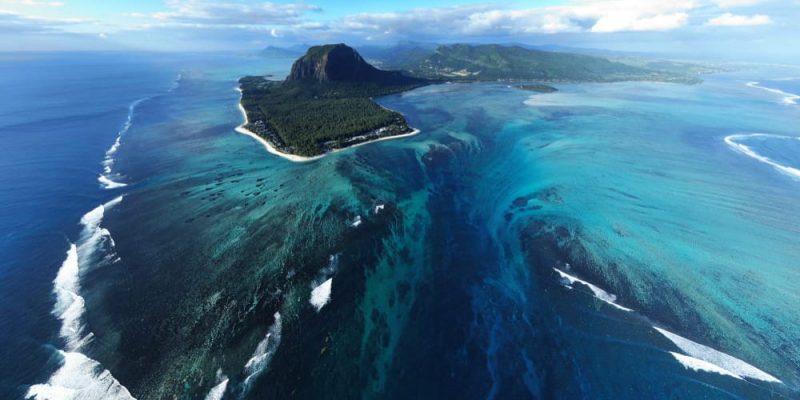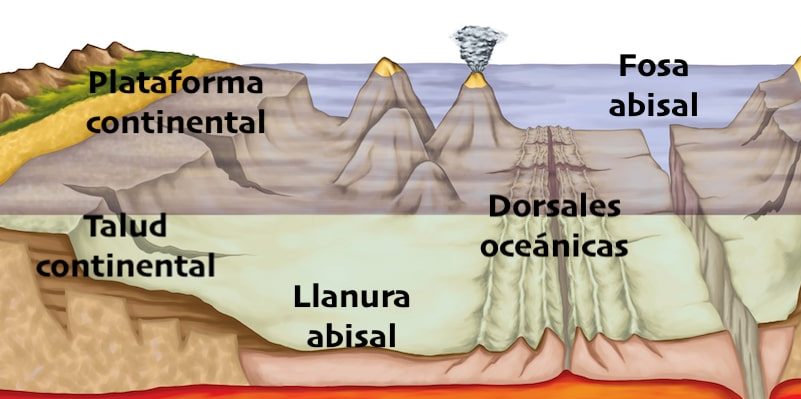We explain what the oceanic relief is, its characteristics and what its shapes are like. Also, what is continental relief.

What is oceanic relief?
In geography, we speak of oceanic relief or submerged relief to refer to the different shapes that the underwater bed acquires, that is, the portion of the lithosphere or Earth's crust that is covered by seas and oceans. In simpler terms, we are talking about the shapes that the seabed takes on.
In this it differs from the emerged or continental relief, which deals with the portion of land protruding from the waters, and which in the current geographical configuration of our planet, is the minority. The submerged portion of the lithosphere occupies about 70% of the total surface of the planet and as it is isolated by water from erosive factors such as wind or rain, it is much less varied in terms of relief than its continental version.
That does not mean that the geological configuration of the seabed is static or immobile, far from it. Like the continental relief, it is in continuous change throughout a very slow process over the centuries, known as the geological cycle, whose manifestations are very difficult to perceive throughout human life.
See also: Physical geography
Features of the oceanic relief
In general, the underwater relief is characterized by the following:
- It is, as we have said, the portion of the lithosphere that is submerged under the water of the oceans: the seabed. Therefore, it reaches important depths in specific regions: extends from 0 to 11 km below sea level.
- They have different margins of volcanic activity, which release terrestrial materials and modify the underwater soil, sometimes giving rise to volcanic islands. Furthermore, they are subject to much more benign erosive forces than on the surface, so Its changes depend mainly on seismic and tectonic activity.
- It is distributed throughout the different layers of ocean water which vary in conditions of pressure, luminosity and presence of life, and which are the bathyal zone, the pelagic zone and the abyssal or abyssopelagic zone.
- The oceanic relief tends to be flatter where sedimentation is strong as a consequence of the sedimentary contribution of rivers, the decomposition of maritime fauna and flora, the erosive action of salt water on the seabed itself, or the contribution of underwater volcanic matter.
Ocean relief forms

Although the oceanic relief tends to be much more uniform and homogeneous than its emerged counterpart, it presents common and recognizable shapes, such as the following:
- The continental shelf. Intermediate area between the continent and the ocean, the extension of the former within the latter, along the coastline to a depth of no more than 200 meters, is considered. It has a variable width, starting from the coast, but it is usually an area with a significant presence of sediments and abundant animal and plant life, which is why it tends towards the plain.
- The continental slope. It consists of a strong underwater slope that connects the continental shelf with the abyssal plain, and that ranges between 200 and 4,000 meters below sea level. It is a more or less irregular fall, with the presence of valleys and submarine canyons, on an inclined plain whose slope usually ranges between 5° and 7°, but can reach 50°, producing numerous slides of sedimentary material. In it, natural steps or steps are common, and life begins a noticeable decrease with respect to the previous area.
- The abyssal plain. This is the name given to the deep plain at the bottom of the seas and oceans, between 3,000 and 7,000 meters deep, usually located between the continental slope and an oceanic ridge or, on the contrary, an abyssal trench. This type of relief constitutes 50% of the ocean floor, and are the main sedimentation areas of the entire planet. Seismic activity is also frequent, which gives rise to small volcanic hills or seamounts (guyots). As it is a region that receives little sunlight, life is much scarcer and temperatures are low.
- The abyssal pits. Also known as oceanic trenches or marine trenches, they are the deepest depressions known on the planet, extending from the abyssal plain to 11,000 meters below the sea surface. Sunlight does not penetrate this unknown region of the oceans, whose waters are around 4° in temperature and are subject to overwhelming pressures. They are usually found near continental edges or volcanic islands, since their origin is clearly tectonic, and contrary to what it seems, they are not free of life, although it is much scarcer and very different from life. of the surface.
- The mid-ocean ridges. The mid-oceanic or mid-oceanic ridges are underwater elevations located in the middle region of the oceans, which can reach heights of between 2,000 and 3,000 meters above the abyssal plain. They have a natural fissure at their top, known as riftwhere magma is continuously emitted, forming new rocks and possible new volcanoes. For this reason, the rocks around them tend to be younger, and new seabed tends to be produced, in a continuous process of renewal of the ocean floor.
continental relief
The continental relief, unlike the oceanic, corresponds to the emerged portion of the earth's surface that is, with the portion of lithosphere that is not submerged under water. Unlike the oceanic relief, which is much more homogeneous, the action of the air, rain and other erosive factors typical of the atmosphere (the greatest drought, for example) make the continental relief very diverse in its forms.
References
- “Ocean relief” in Wikipedia.
- “Earth relief” in Wikipedia.
- “Types of relief” at the Bernardino Rivadavia Technical School (Argentina).





